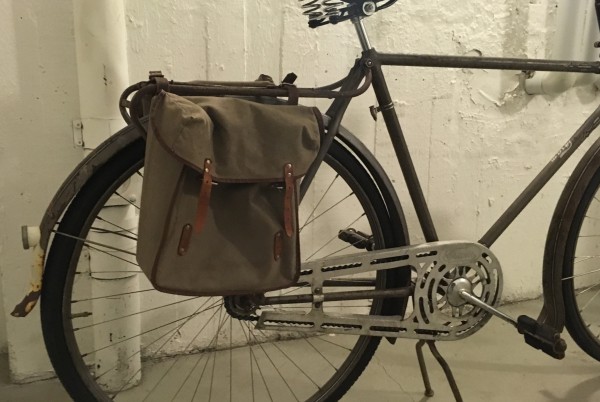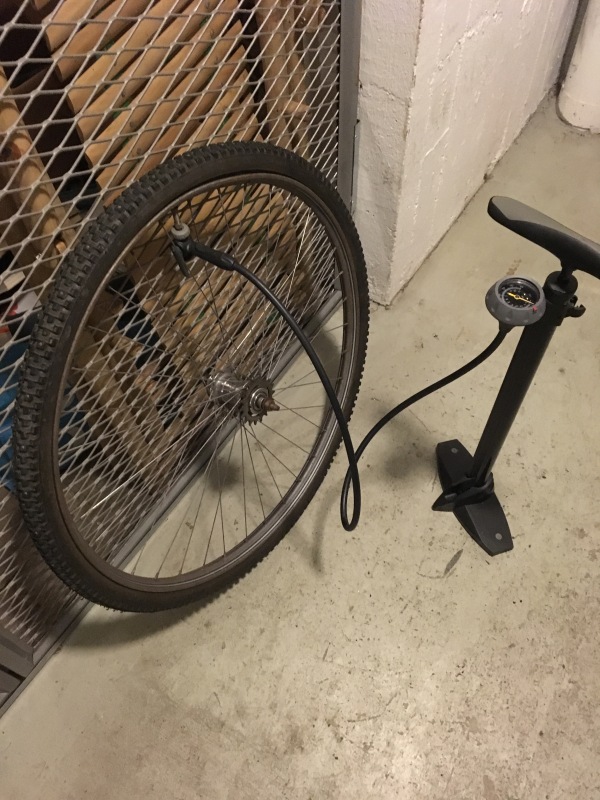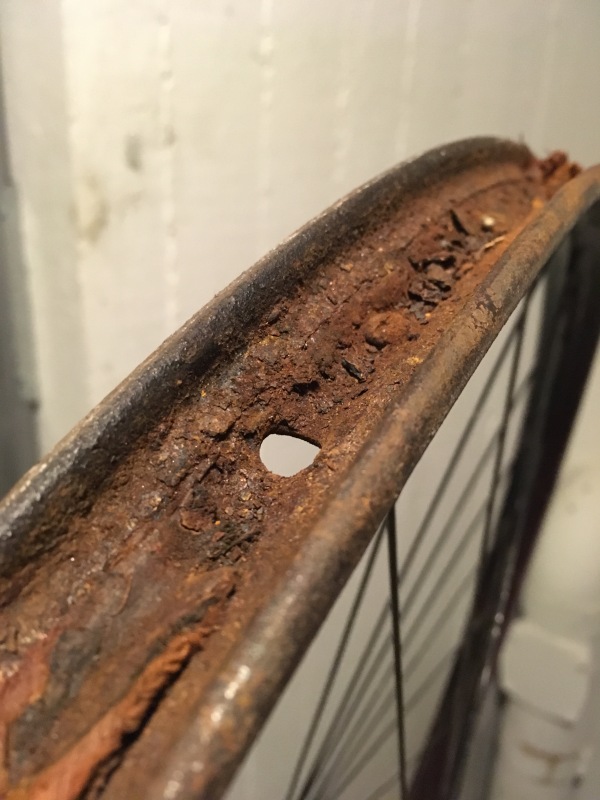What to do when Christmas season is getting close? Should I clean the flat? Buy a Christmas tree? Or even do the national sport of run around in shops, searching for last minute Christmas gifts while wrestling people?
This year I think I made the perfect choice. I simply went down to the basement for an relaxing session with my winter project. The Uppsala made Fram bicycle I mentioned in an earlier post. It was nice and calm to sit in the basement while listening to vintage music and repairing vintage bicycles, avoiding the ever present hysteria in the city.
Long ago I created a playlist called ‘Smoke rings‘ on the musical streaming service Spotify. That is an playlist with mostly European jazz, swing and dancehall music from 1930’s up to 1950’s. In short, perfect selection of music to get in the mood (see what I did there?) while servicing and repairing and old bicycles.

The Fram made in Uppsala about 1942 is now almost complete.

Brooks B66 saddle, rusty old ASEA headlight with cracked glass, I also found an original mudguard emblem at an auction.
First of all, the Fram bicycle needed a good cleaning after, what I suspect, being in a barn for the most part of the latest 50 years. Spider webs, dust, bird droppings, more dust, occasional insects, old mud, did I mention even more dust, was covering the entire bicycle. Off to the car wash with the entire bicycle. After degreasing, washing, shampooing, rinsing and a coat of wax later the Fram looks rather nice. Still rusty, but cleaner.

Old and used, but can still provide many happy miles of riding.
After returning the bicycle to my basement, I started to look it over, it was in a good original condition. I decided there was no need to dismount and grease all the bearings, they all seemed to be in working order. But of course, the front hub and rear hub with the brake will get an overhaul later in the spring. It is better to be safe than sorry, after all. The possibility to break is an overall good option to have. The cranks felt firm and had no strange sounds or odd feel to them when I turned them over. The same was for the pedals and front fork bearings. All bearings were surprisingly smooth and fine.
The worst rust damages on the entire bicycle was found on the handlebars and stem. The rust was caused by the chrome coating had flaked off many years ago and exposed the metal underneath. I looked in my old box of various parts. I knew that I had an old handlebar there, it is not the original shape. But I prefer the higher angle of handlebars rather than the original low ones. It makes the bicycle ride, a more gentlemanly way of promenade cycling. No laying double folded over the handlebars for racing or the sensation of speed. Sitting straight is the bees-knees.

Well worn 1940’s wooden grip
I had a pair of old wooden grips in a drawer. They were once painted silver. But after years of wear and tear, the paint had cracked. I sanded them down and oiled the wood for a more natural look instead. In the box of parts I also found the ASEA dynamo and the old cracked ASEA head light that I used on the £20 bicycle.
I also found a saddle in that bottomless box, sadly it was a fairly modern Brooks B66 saddle. But it fitted the overall look so I mounted it on the bicycle as well. The same went for the vintage saddle bags in canvas that I never got around to use. Mounted on the luggage rack, they fit the look perfectly as well.

The canvas bags looks like they were made for the bicycle. Not impossible, since the might be the same age.

Perhaps I will add an Stockholm license plate from the 1940’s to complete the look?
The idea I had for the Fram was to mount studded winter tires so I could use the bicycle when it is snowy and icy outside. A short ride in snow is no problem, store the bicycle in a warm place does the trick to prevent rust, or in this case. More rust, since the rims were already slightly rusty.

Fitting a studded winter tire to the front wheel, so far so good.
There is a few more dangers of using old bicycles, or bicycles in general when it is cold. The possibility for moist getting inside the rims and cranks are bigger on the winter when snow gets stuck on the bicycle. When the snow melts the water seeps inside the parts. If it is cold at night the water can freeze and transform to ice. Ice expands, so rims and other parts can crack. Not always, but it can happen. When a bicycle is in a worn condition like the Fram from 1940’s, I feel it unnecessary to chance.

When riding in snow it is important to storage the vintage bicycle in a warm place over night. Not leave it outside. On the photo, 1950’s Crescent left for weeks outside.
I mounted a winter tire on the front wheel and tried if it would fit in the fork, it all seemed to work out. But the rear wheel had some surprises in store for me. First of all, the rear wheel was slightly warped and wobbly. I can live with that. But the issue that made me rethink the decision to use winter tires, was that the wheel sits in an slight angle. Most likely because at some time in its earlier life the rear wheel meet a side walk curb or equal unforgiving edge. The rim is dented on a 5 centimetre long area, so much so that the spoke that holds that part of the rim has been bent and makes the wheel wobble and jump when turning.
Because of that, when I tried the wheel in the frame with the wider winter tire mounted, the tire got stuck against the frame. It did not matter how much I tried to adjust the wheel, sideways, up, down, forward, backwards. It always got stuck against the frame. Sadly I had to abandon the winter cycling plans and mounted narrower standard tires instead. Then it all worked just great.

As an example of an rusty rim: The front wheel of the £20 bicycle that was a complete wreck. The original rim tape that was made in cotton had soaked up water and created rust over the years. The Fram rims just had some surface rust, nothing dangerous but worth to keep an eye at. But the rust will be limited if not riding in the rain or winter so often.
In short, when the snow melts in the spring I will take the Fram bicycle for a test ride. Then I will decided if I will have a professional workshop to have a look at the rear wheel if it is possible to fix it, or not.
Let us hope that it rides as good as it looks.